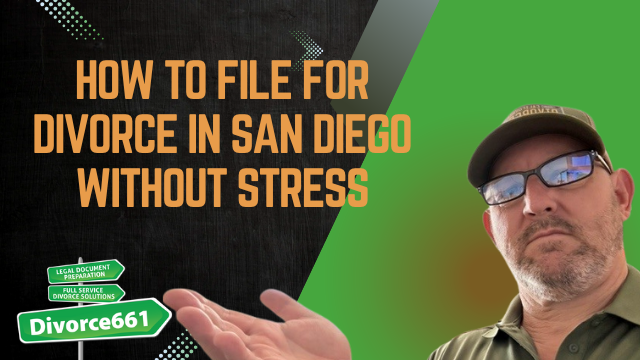How to File for Divorce in San Diego Without Stress | San Diego Divorce
In this guide, Tim Blankenship of Divorce661 explains a straightforward, low-stress approach to filing for divorce in San Diego. Divorce often feels like a mountain of paperwork and court runs, but with the right steps and a little help, the process can be organized, transparent, and far less stressful.
Overview: The Simple Roadmap
Start with the essentials and move step-by-step. Below is a clear roadmap that covers what forms you need, how e-filing works in San Diego, proper service of papers, financial disclosures, reaching agreements, and filing your final judgment package.
Step 1 — Begin with the Required Forms
The paperwork that starts a California divorce generally includes:
- Petition (the paperwork that formally starts the case)
- Summons (notice to the other party)
- UCCJEA / Child-related jurisdiction forms if you have children (to establish which state has authority over child custody)
Getting these documents right from the beginning reduces delays later on. If any of these forms are incomplete or incorrect, it can complicate service and court processing.
Step 2 — E-filing Is Mandatory in San Diego
San Diego requires electronic filing (e-filing). That means you don’t have to physically go to the courthouse to submit your documents—but it also means you must follow the e-filing system rules carefully.
Common pitfalls when e-filing:
- Uploading incorrect or incomplete forms
- Missing mandatory attachments
- Failing to follow county-specific formatting or filing requirements
Fixing e-filing problems can be time-consuming. That’s why many people choose professional help to ensure filings are accepted the first time.
Step 3 — Serve Your Spouse Properly
Service of process is a legal requirement: your spouse must be served with the petition and summons so the court can proceed. Important rules:
- You cannot serve the papers yourself. Service must be done by someone else who is over 18 and not a party to the case, or by a professional process server.
- File a Proof of Service document with the court after service is completed. This documents when and how service was made.
- Incorrect or missing proof of service will delay the case.
Getting service right is crucial to keep timelines moving and avoid unnecessary setbacks.
Step 4 — Exchange Financial Disclosures
Financial transparency is non-negotiable in California divorces. Both parties must exchange financial disclosures so the court (or the parties) can make informed decisions on support, assets, and debt division.
- Disclosures typically include income, assets, debts, and expense information.
- Failing to disclose or hiding information can lead to penalties and undermine settlement negotiations.
- Exchanging disclosures early often makes settlement easier and faster.
Step 5 — Reach Agreements When Possible
Many divorces become stressful because parties get stuck in disputes. If you and your spouse can negotiate and agree on key issues—child custody, support, property division—you can avoid prolonged court battles. Mutual agreements simplify the process and reduce cost and emotional strain.
When agreements are reached, they are documented and submitted to the court as part of the final judgment package.
Step 6 — File the Final Judgment Package
Once forms, service, disclosures, and agreements are in order, the final step is filing the judgment package. This set of documents finalizes the divorce and records the court’s orders. Filing the final judgment package marks the completion of the process and brings you closer to a new beginning.
Real Client Example: Sarah’s Story
One client, Sarah, tried to manage the entire process herself and became stuck in the e-filing system. Overwhelmed and frustrated, she reached out for help. We stepped in, resolved the e-filing issues, filed the correct paperwork, handled service and disclosures, and finalized her case quickly and without added stress.
Her experience highlights a common reality: DIY is possible, but professional support can save time, reduce anxiety, and prevent costly mistakes.
Why Consider Professional Help?
Professional services can manage the process from start to finish so you don’t have to spend time learning court rules or troubleshooting e-filing issues. Typical benefits include:
- Flat-fee pricing with no hidden costs
- 100% remote process—no courthouse visits required
- Fast, accurate, court-approved filing and document handling
- Personalized help at every step to keep your case moving
Quick Checklist: Filing for Divorce in San Diego
- Prepare petition, summons, and UCCJEA (if children are involved).
- E-file the initial paperwork through San Diego’s e-filing system.
- Have someone else serve your spouse and file Proof of Service.
- Exchange financial disclosures promptly and thoroughly.
- Negotiate agreements on custody, support, and property division, if possible.
- File the final judgment package to close the case.
Conclusion and Next Steps
Filing for divorce in San Diego doesn’t have to be overwhelming. Start with the right forms, respect the e-filing rules, serve correctly, exchange financial disclosures, and aim for mutual agreements when possible. If the process becomes complicated, professional help can resolve issues quickly and reduce stress.
Ready to file the easy way? Visit divorce661.com to schedule a free consultation and see how a full-service, flat-fee, remote divorce option can simplify your path forward.

